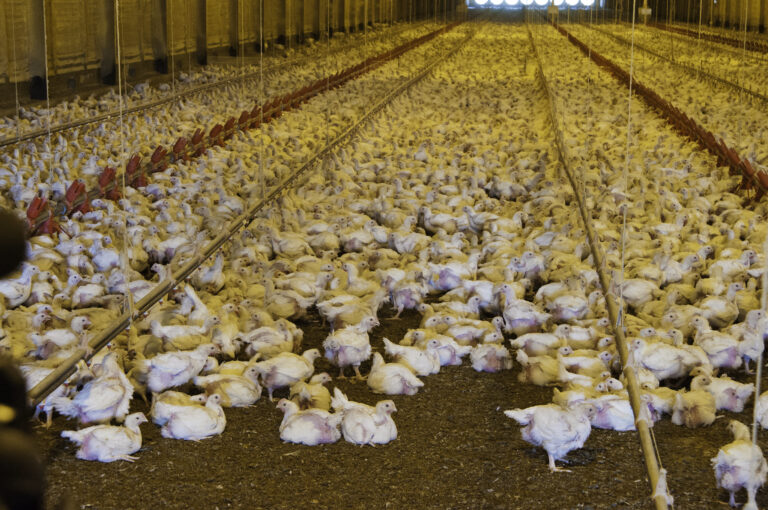Ross Slaughter is a student at Harvard Law School and a member of the Labor and Employment Lab.
Hundreds of thousands of farmers across India are protesting new agriculture laws that they worry will destroy their livelihoods and leave them at the mercy of large corporations. In the six months since the laws were passed, the movement has only grown, becoming the most serious challenge to Prime Minister Narendra Modi since his election in 2014. While the economic plight of farmers remains at the heart of the movement, it has also become the latest battleground in the struggle against Modi’s increasingly undemocratic and nationalistic tendencies.
Fifty years after the Green Revolution, Indian farmers are in crisis.
India’s agricultural sector is marked by desperation and poverty. Close to sixty percent of India’s population support themselves through farming, yet it accounts for only a small fraction of the country’s GPD. Eighty-six percent of India’s farmland is worked by farmers who own less than five acres of land. Almost 70% own less than three. Most farmers are in debt, and more than twenty thousand committed suicide between 2018 and 2019. Many studies identify indebtedness as the largest factor driving the suicides, and both problems have only grown worse during the pandemic.
India’s agricultural woes trace their roots to the Green Revolution of the 1960s, when the Indian government sought to end hunger — and stave off more radical land reform — by offering farmers minimum prices for high yield, capital-intensive foods crops like rice and wheat at state-run markets (known as mandis). While the program dramatically reduced food scarcity and turned the states of Punjab and Haryana into the breadbasket of India, it has had devastating ecological consequences and left farmers dependent on the government to purchase surplus crops. Most, including farmers, agree that Indian agriculture needed to change, but few were prepared for the events of the last year.
Farmers believe that new laws, crafted without their input, will only make things worse.
Last June, in midst of the COVID-19 outbreak and while parliament was out of session — India’s cabinet, led by Prime Minister Modi, issued three ordinances aimed at modernizing Indian agriculture. The ordinances allowed buyers and sellers to bypass the mandis, contract directly with one another, and stockpile crops. They also limit farmers’ ability to bring contract disputes to court. In a disputed voice vote last September, the Indian parliament passed the ordinances into law.
While the central government argues that the laws will spur investment and cut out middlemen, farmers fear the laws will push them further into poverty. Finally free to contract with individual farmers, corporations will use their disproportionate bargaining power to demand lower prices and limit credit. As one economist put it, the biggest problem with the bills may be the “complete absence of regulation and regulatory oversight.”
Farmers also worry that the laws spell the end for the Minimum Support Price (MSP) system. While the new laws do not explicitly address the MSP, its functioning depends on robust government purchases. The MSP is simply the price the government offers for certain cereals, not a legal minimum. If state-run mandis wither and government purchases dry up, it may become meaningless (as it already is for the vast majority of Indian farmers, whose crops are not covered by the MSP or who lack access to government purchasers).
Finally, farmers objected to the way in which the laws were passed: without any meaningful input from the farmers themselves. Instead, they argue that the laws are designed to benefit large Indian conglomerates associated with the Modi government.
Farmers, and their allies, rise up in protest.
Farmers began protesting the ordinances last summer, and demonstrations quickly grew after the laws were enacted in September. In late November, hundreds of thousands of farmers marched to New Delhi, India’s capital. They were stopped at the outskirts of the city, where they have been encamped ever since. Their principal demands are simple: repeal the new laws and legally guarantee minimum support prices for all crops.
The Joint Farmer’s Front (Samyukt Kisan Morcha), an umbrella organization of farmers’ unions, is spearheading the protests. Support for their cause is broad and deep. The protestors span multiple generations, and women have taken a leading role. In December, as many as 250 million people across India participated in a general strike in solidarity with the farmers. The protests have even spanned caste and class, uniting farmers and agricultural workers. As one labor union leader explained, “[t]he three farm laws will not just ruin the farming community; these will snatch bread from the hands of the labourers as well.” The protests have also garnered a diverse group of supporters abroad, from U.S. farmers’ unions to labor unions and farmworker groups.
The normally peaceful protests intensified at the end of January, when protesters on tractors entered the city and briefly took control of the historic Red Fort during India’s Republic Day celebrations. The government responded with violence, teargassing and charging protestors. In the aftermath, the government has employed increasingly authoritarian tactics against the protestors, including shutting off the internet, electricity, and water at the protest camps outside New Delhi, and using a colonial-era sedition law to arrest journalists and activists supporting the protests.
The government and members of the ruling Bharatiya Janata Party (BPJ) have also tried to exploit the fact that many of the protestors are members of India’s Sikh religious minority, falsely implying that the protesters have an anti-national or secessionist agenda. While many Punjabi farmers, most of whom are Sikh, do see a connection between their protests and earlier struggles against oppression by the British and Indian governments, they worry “any acknowledgement of the role of Sikhism in the protests” will be used to undermine support for the farmers in the rest of India.
Despite this resistance, the protests show no signs of abating. Leaders say they are preparing to continue the protests through harvest season, which begins this month. Protests have also continued around the country, particularly in Punjab and Haryana. On February 6, farmers set up more than ten thousand roadblocks across the country.
The farmers have already drawn concessions from India’s usually uncompromising Prime Minister, including offering to exempt farmers from new air pollution laws, amend the farm laws, or suspend them for up to two years. But the movement’s leaders have consistently rejected these offers, accepting nothing less than complete repeal and legally guaranteed minimum support prices.
While the protests emerged in response to the agriculture laws, they have come to symbolize much more. In addition to economic justice for farmers, many see the protests as a challenge to the Prime Minister Modi’s anti-democratic and majoritarian approach to governing. The swift passage of the agriculture laws is emblematic of the Modi government’s dictatorial style, including the 2019 abrogation of Kashmir’s autonomous status. Its attempts to silence the protestors are also nothing new. India has selectively shut off the internet more than 400 times since 2016, more than any other democracy. And its efforts to paint the farmers as disloyal minorities feeds into the Hindu nationalism that has increasingly defined Modi’s time in power. What remains to be seen is whether the farmers and their allies can overcome these obstacles. Their survival, and the future of Indian democracy, may depend on it.










Daily News & Commentary
Start your day with our roundup of the latest labor developments. See all
January 7
Wilcox requests en banc review at DC Circuit; 9th Circuit rules that ministry can consider sexual orientation in hiring decisions
January 5
Minor league hockey players strike and win new deal; Hochul endorses no tax on tips; Trump administration drops appeal concerning layoffs.
December 22
Worker-friendly legislation enacted in New York; UW Professor wins free speech case; Trucking company ordered to pay $23 million to Teamsters.
December 21
Argentine unions march against labor law reform; WNBA players vote to authorize a strike; and the NLRB prepares to clear its backlog.
December 19
Labor law professors file an amici curiae and the NLRB regains quorum.
December 18
New Jersey adopts disparate impact rules; Teamsters oppose railroad merger; court pauses more shutdown layoffs.